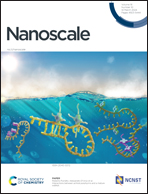Merging gold plasmonic nanoparticles and l-proline inside a MOF for plasmon-induced visible light chiral organocatalysis at low temperature†
Abstract
Light-driven asymmetric photocatalysis represents a straightforward approach in modern organic chemistry. In comparison to the homogeneous one, heterogeneous asymmetric photocatalysis has the advantages of easy catalyst separation, recovery, and reuse, thus being cost- and time-effective. Here, we demonstrate how plasmon-active centers (gold nanoparticles – AuNPs) allow visible light triggering of chiral catalyst (proline) in model aldol reaction between acetone and benzaldehyde. The metal–organic framework UiO-66–NH2 was used as an advanced host platform for the loading of proline and AuNPs and their stabilization in spatial proximity. Aldol reactions were carried out at a low temperature (−20 °C) under light illumination which resulted in 91% ee with a closed-to-quantitative yield, 4.5 times higher than that without light (i.e. in the absence of plasmon triggering). A set of control experiments and quantum chemical modeling revealed that the plasmon assistance proceeds through hot electron excitation followed by an interaction with an enamine with the formation of anion radical species. We also demonstrated the high stability of the proposed system in multiple catalytic cycles without leaching metal ions, which makes our approach especially promising for heterogeneous asymmetric photocatalysis.



 Please wait while we load your content...
Please wait while we load your content...